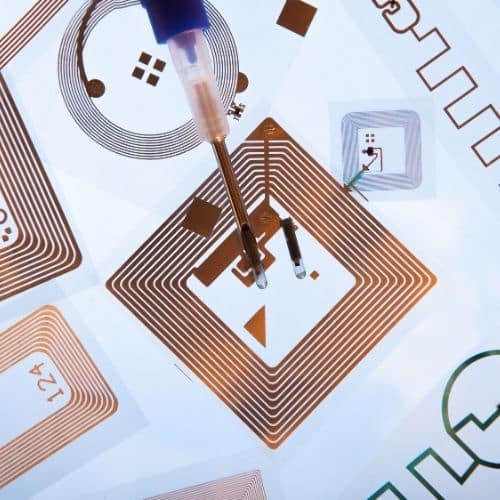Find out how to choose the best asset tracking software. Know what improves your business’ asset management operations and take your tracking further.
Asset Tracking and the Film Industry
Asset Tracking and the Film Industry
Movies are not just teamwork. Teamwork implies one group of people working on one thing. Movies are so much more than that. Yes, at any one time during the production phase there may be one main team working on the movie. Maybe it’s even a smaller project with a close-knit and talented team. Sooner or later, however, there will be liaison. Asset tracking can do so much to help out with teamwork. Find out how below!
One team making sound, one team in charge of lights, one team filming, more than one team editing, one team pointing everyone in the right directions, one team finding the directions, one team writing. There’s such a wide array of things to do to create something magical and musical and enticing on screen.
It may seem impossible to keep track of everything, but with careful planning, tight communication, and great delegation skills it is possible. There are ways of making this easier, however, such as using asset tracking. Because of the density of work that has to be done on any film, whether music video or blockbuster, certain teams tracking their own assets can help. Especially when those at the top, delegating and hiring, can also see and track the same assets.
This article is the first of many on how asset tracking can help make a movie, so to take a whistle-stop tour, how can asset tracking help at each stage of the filmmaking process?
The Filmmaking Process
The Filmmaking process can be long, but with every step and every change gets more and more exciting by the moment. The phases of making a movie can help break down every step of the process and make everything a little bit more manageable, but this doesn’t mean that it can’t be made even easier with asset tracking.
Asset tracking can help you along every step of the way because there are so many materials and so much equipment that go into movie magic, and every single thing is important. If that light goes missing, filming can screech to a halt. After all, it’s always helpful when the audience can actually see the actors.
So, what can it do at each stage? How can asset tracking help you inventory?
Pre-production
The pre-production stage is for planning and to pin down the vision. There are lots of scrunched up sheets of paper. There are a lot of frowns and thinking hard. There are a lot of creative differences.
If there aren’t physical assets, however, and if it’s all in your head or scribbled on sheets of paper, how can asset tracking help?
This may depend on you. It may depend on how you work. You might be making an unscripted film, or a film with deliberate gaps for improvisation. You might be like Kubrick, however, and have seventeen drafts of your script to stick to, ready to take shot after shot after shot after shot of the same scene.
Whatever it may be, there will always be a planning phase at pre-production. There should be timetables drawn out in order to keep your actors and crew happy, drafts of the screenplay, some with directors notes and some without, and plans about the needed equipment amongst other things.
These, therefore, are your assets. With itemit, you’ll be able to categorise your screenplays and inventory them so that they don’t get mixed up with your storyboards. Also, you’ll be able to link your storyboards, your equipment needed, your shot lists, and your screenplays so that when you come to check what’s needed for a day of shooting, it’s all in one place. On top of this, you don’t even need to tag physical assets, you can enter your thoughts or ideas onto the app if you need to!
When you start hiring equipment, with a better inventory system and a better and faster way of planning, there is much less of a chance that duplicates will be bought, or that equipment thought to be needed will turn out useless. Also, you’ll be able to see what needs to be where and when a lot easier thanks to a more organised way to track assets, meaning that you can save time and money. No more running after the cameras that have ended up somewhere where they shouldn’t be!
Production
Picture the scene. EXT. MOVIE SET. DAY. The morning sun is rising. This shot will be on the trailers, the posters, everything because the gleaming rays are just so gorgeous as they rise up from beyond the horizon. The director has a tear in their eye as they look beyond the sunrise. They’ve made it. Years of student films and paying their dues and now… Now they’re finally here. Even the method actors break character to crack a smile.
The director takes in a deep breath. “Lights. Camera. Action”. There is a pause. “We don’t have the right camera.” Someone calls out. The sun rises. The shot is gone forever. Of course, this is the worst-case scenario, but nobody wants to be in this situation. Everyone in the film industry knows that things hardly ever go according to plan, but with asset tracking, there’s less that can go wrong.
One of the most attractive things asset tracking and management can give you in the production stage will make the cast, the crew, the bosses, and the extras leap with joy. It can help save you time when you’re setting up a scene.
If you know where all of your assets are at the beginning of the day, when you’re staring at the field that’s going to become a battleground or a campsite or the scene of a grizzly murder, then knowing what you need to bring in, when, and how will help everything run a lot more smoothly and a lot more quickly.
The faster you set everything up, the higher the morale, the less money you need to spend on venues, the easier it is to meet deadlines, and the better the performances. This is an extra breath of fresh air if your actors don’t like waiting around. If, while they’re standing around in their coats with their breath on the wind, every coffee gets them more and more riled up, less time on setup is more than welcome, unless their frustration is going to improve their performance in which case you can deliberately go slowly.
As well as this, production is broken up into teams. So, so, so many teams. There’s the lighting team, the sound team, the camera teams, in fact, there’s almost a team for everything in order to capture life as closely as possible. With itemit, it’s a lot easier to delegate and trust that the teams are doing everything that they should be. You’ll be able to sit back and know that the lighting team have inventoried and managed their equipment efficiently, and so they’ll know sooner if something goes wrong. This means that there’ll be fewer breakdowns on set, whether that’s in terms of a floodlight, as itemit can give reminders about when equipment needs to be serviced, or if it’s in terms of the director.
One of the best things about the movie business is that it’s always growing and it’s always improving (in general, there are some recent films that can be ignored here). The technology itself, though, is always improving. It’s more important than ever to keep track of your assets, because there’s always something new that has a new purpose that you might want to invest in. If you want the next “steadicam”, and think it’ll improve your film, you can more easily see how well it fits in with your existing equipment.
This is also related to how a lot of equipment works. You may have a camera but that’s not necessarily enough. Technically, yes, it is enough. If you have a good vision and good planning and good actors, all you need is a smartphone to make movie magic. However, if you’re making something with more of a budget or something that you want to be more crisp and professional, your camera may have a variety of things that need to be added to it. It’s helpful, therefore, to be able to link the shotgun mic to the tripod to the camera to the “dead cat” to the lenses with the itemit app. Then, you’ll be able to build what you need much faster. If you instantly know where everything is and if it’s linked together, less time is wasted and more filming is done.
Of course, there are also props. If prop managers can inventory more efficiently and better, then it’s a much more instant process of “have you got this?” “one second…” *checks the itemit app* “Yeah”, rather than having to rely on memory. This cuts down on the possibility of buying duplicates and because the assets are tracked, props can be found a lot more quickly meaning that there’s more time for other things, or more time to look at more props and find the one that looks the best for your movie.
Wiring can also be a bit of a nightmare when it comes to filming. Not only do you need to make sure the wattage is correct to make sure there is no shortage on set, cables also have to be hidden so that illusions and magic aren’t broken. With RFID tags, it is possible to track wiring and to label the wattage and also keep the wiring hidden. RFID scanners don’t need a line of sight to “find” assets so your movie can be kept as gritty and as real as possible.
This also helps with rigging in terms of practical effects, cameras and equipment. If there’s less time spent on rigging everything and if it’s more efficient, then it’s possible to get more done. This is great if you constantly find yourself saying “we’ll fix it in post”! More time also means less money spent, of course, which is an added bonus.
One of the best things about making a movie is how all of the stages fit together. From pre – to prod – to post, everything slowly just meshes together. What this means, however, is that if there isn’t enough foresight in the previous step, issues can arise later. With asset tracking, you can instantly start tracking your footage, your backups, and your backups of backups meaning that the second it’s saved, you’ll know where it’s being left.
Post-production
It has been years since celluloid was the favourite method of making films. This doesn’t mean you won’t be making yours on celluloid and splicing it the old fashioned way, but no matter how you’ve filmed your movie, whether it’s digitally or not, you will have footage somewhere.
This footage needs to be shipped to a variety of different places and backups after backups are needed. Even if it’s mostly online, you will still have a lot of physical film such as memory sticks, SD cards, and maybe even celluloid. This footage then needs to go to editors, whoever you’re commissioning to make the trailer, and special effects artists. Edited footage then needs to go to sound designers, Foley artists, and musicians. Every piece of footage seems to breed several more. In short, there’s a lot of footage going to a lot of different places, and so asset tracking can help speed this up. With a spreadsheet, there’ll be far too much to track, but with itemit the process is a lot faster, and a lot easier.
If the editor doesn’t have their footage when they need it, there are delays.
With asset tracking you can track where everything is, which scenes you’ve sent to who, and which software is being used by which people. So, even if you aren’t using physical assets to track the film and you are mostly online, you can track the laptops or computers themselves to see who is supposed to have what and when and whether they actually do or not.
In the post-production phase, time is of the essence. The deadline seems closer than ever, and so it’s important to know where you’re really at any given moment. This is also because you don’t know what reshoots are needed or what dubbing. If you discover this faster, you can still spend less and work more consistently towards a set deadline.
To Conclude
This was itemit’s first article on the film industry, and a bit of a quick tour. There are so many different teams that can benefit from asset tracking for films that in the future we’ll be looking into them more specifically.
Foley artists and all of their materials, camera teams and all of their equipment, editors and all of their software and computers. There is so much to do and so ensuring synchronisation is of utmost importance. With itemit this is a lot easier, and instead of just lots of smaller teams working on different things at different times, asset tracking can bring everyone together and bring the vision to an audience near you.
Film Equipment Asset Tracking
Choose a better way to track your assets
Start your free 14-day trial now
Instant access. No credit card details required.
Related articles
Best Asset Tracking Software: How to choose the best software for you
How Asset Labels Improve Your Asset Tracking
Asset labels save you time which, in turn, saves you money. You can also use asset labels to unlock various accountability improvements.
How A School Asset Register Saves Your School Money
A school asset register will save your school money. Find out more about the time and cost saving benefits of asset tracking software.





